Leptogeneia is a genus of moth in the family Gelechiidae. It contains the species Leptogeneia bicristata, which is found in Australia, where it has been recorded from New South Wales.

Lichenaula tuberculata is a moth of the family Xyloryctidae. It is endemic to Australia, more specifically the Australian Capital Territory and New South Wales.
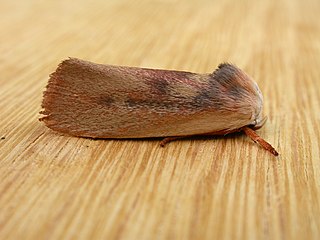
Cryptophasa rubescens is a moth of the family Xyloryctidae. It is found in Australia, where it has been recorded from New South Wales, Queensland and Victoria.
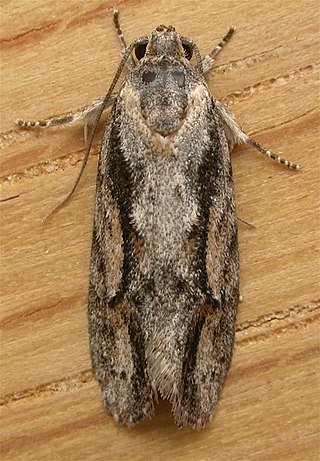
Agriophara leptosemela is a moth of the family Depressariidae. It is found in Australia, where it has been recorded from South Australia, the Australian Capital Territory, New South Wales and Queensland.
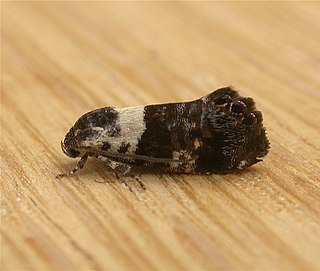
Eupselia aristonica is a species of moth of the family Depressariidae. It is found in Australia, where it has been recorded from New South Wales, the Australian Capital Territory, Victoria and Tasmania.

Eupselia satrapella is a species of moth of the family Depressariidae. It is found in Australia, where it has been recorded from Queensland, New South Wales and the Australian Capital Territory.
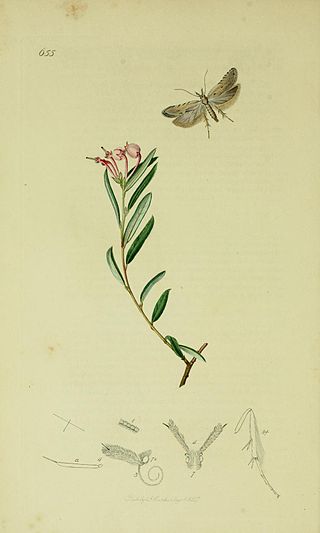
Anarsia spartiella, the Wanstead grey, is a moth of the family Gelechiidae. It is found in most of Europe.
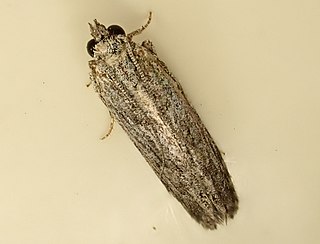
Anarsia dryinopa is a moth of the family Gelechiidae. It is known from Australia and the warmer regions of New Zealand in both the North and the South Islands.
Anarsia epiula is a moth of the family Gelechiidae. It was described by Edward Meyrick in 1904. It is found in the Australian states of New South Wales and Queensland.
Anarsia leucophora is a moth of the family Gelechiidae. It was described by Edward Meyrick in 1904. It is found in New South Wales.
Symbolistis orophota is a moth in the family Gelechiidae. It was described by Edward Meyrick in 1904. It is found in Australia, where it has been recorded from southern Queensland and New South Wales.
Anarsia tortuosa is a moth in the family Gelechiidae. It was described by Edward Meyrick in 1913. It is found in Japan (Ryukyus) and Sri Lanka.
Ardozyga anthracina is a species of moth in the family Gelechiidae. It was described by Edward Meyrick in 1904. It is found in Australia, where it has been recorded from New South Wales.
Ardozyga compsochroa is a species of moth in the family Gelechiidae. It was described by Edward Meyrick in 1904. It is found in Australia, where it has been recorded from South Australia and New South Wales.
Ardozyga gorgonias is a species of moth in the family Gelechiidae. It was described by Edward Meyrick in 1904. It is found in Australia, where it has been recorded from Queensland.
Ardozyga trichosema is a species of moth in the family Gelechiidae. It was described by Edward Meyrick in 1904. It is found in Australia, where it has been recorded from Western Australia.
Aristotelia thetica is a moth of the family Gelechiidae. It was described by Edward Meyrick in 1904. It is found in Australia, where it has been recorded from New South Wales and Tasmania.

Antipterna euanthes is a species of moth in the family Oecophoridae, first described by Edward Meyrick in 1885 as Ocystola euanthes, with the female lectotype being found in the Wirrabara Forest, South Australia. It appears to be a moth endemic to Australia and in addition to South Australia is also found in Victoria, New South Wales, and Queensland.
Antipterna acrobaphes is a species of moth in the family Oecophoridae, first described by Edward Meyrick in 1885 as Ocystola acrobaphes. The holotype was collected in Sydney, New South Wales, in January 1878.
Antipterna glacialis is a species of moth in the family Oecophoridae, first described by Edward Meyrick in 1885 as Ocystola glacialis. The holotype was collected at Mount Lofty, South Australia.








